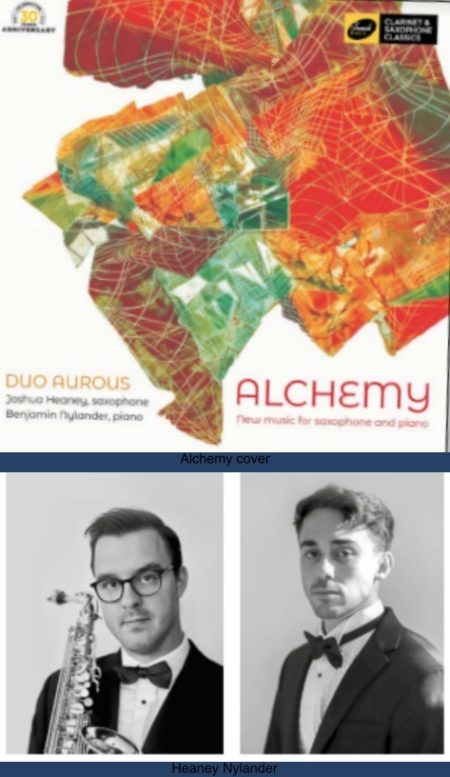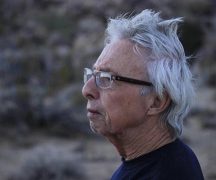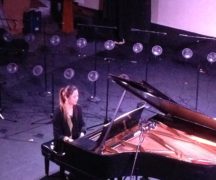By DAVID DUPONT
BG Independent News
When saxophonist Joshua Heaney and pianist Benjamin Nylander were working on the duo piece “Distances Within Me,” they ironically were a distance apart.
It was during the pandemic. Nylander was staying in Bowling Green completing his master’s degree in composition. Heaney, who is a student in the Doctor of Contemporary Music program, was staying with his in-laws in Pennsylvania.
“In COVID we just didn’t know when we’d be able to play live again,” Heaney said.
Eventually, they did come back together to perform it live on Heaney’s degree recital in April 2021, albeit for an audience of four, which included the saxophonist’s wife Mackenzie Heaney, a soprano who is also a BGSU student.
The recital also included “Lacrimosa” by Marilyn Shrude, who was Nylander’s composition teacher.
Those pieces ended up on “Alchemy” the first recording by Duo Aurous.
They had envisioned hitting the road for a tour, but COVID-19 killed that idea. With a grant from the College of Musical Arts, they were able to shift gears and record the album instead.
The project was “very pie in the sky,” Heaney said. “BGSU was very supportive. … That enabled us to shoot high.”
“Josh was organizer of the business side of the project. He worked very diligently getting it all together, and I hopped on for a ride. … The whole thing came together quite naturally. We just said let’s make an album. We just jumped into it.”
The album, “Alchemy,” was recorded at BGSU in May, 2021 and released last October by Samek Music.
The concept behind the duo is a balance between the instruments “where both players were equal forces,” Heaney said. “Especially with saxophone and piano, usually the saxophone dominates the soundscape a bit.”
Nylander said he was not interested in simply being an accompanist. “For this album we were trying to find a strong cohesion between the piano and saxophone.”
They selected all the pieces with that in mind. They wanted music that was “emotionally affective,” Nylander said. “It either touches you or not.”
Including “Lacrimosa” was a given. Marilyn Shrude, Nylander’s teacher, wrote it for her husband, John Sampen, Heaney’s teacher. “A Simple Song” was included to honor another of Heaney’s teachers, the late Fred Hemke, whom he studied with at a summer music institute in Maine.
The last piece to come together was Nylander’s own “Body of Water” because “it took me so long to write, the composer said.
He had drafted another piece and threw it away. Then he started anew with a set of pitches, and it expanded from there. He kept doodling, putting together pitch sets. “It became like this puzzle.”
The piece involves an element of chance with the instruments drifting apart, and then aligning.
He sent fragments to Heaney, asking him about special, extended saxophone techniques, and how they worked.
Then there were “these runs that I forced him to do,” Nylander aid. “He worked very hard to get these very fast sections.”
He finds it difficult to write for himself. He tends to overestimate how much time he’ll have to master the part.
“’Body of Water’ is achievable,” Nylander said. “I didn’t want to make it crazy difficult so it wouldn’t be doable. I actually had to force myself to tone it down because I know we can do so much.”
Heaney and Nylander both attended Susquehanna University for their undergraduate degrees, though Heaney had just graduated when Nylander arrived. Still, Heaney was aware of Nylander’s work both as a pianist and as a composer.
Heaney started his musical studies on piano as a child, but soon had to quit. Because of his serious vision problems, he had great difficulty with the piano music. Then one day when he was in fifth grade, his mother remembered it was time to choose instruments for school band. He was attracted to the saxophone, in part because of its “weird shape” and it was shiny, and President Bill Clinton played it.
“I haven’t been able to put it down since,” he said.
Nylander started playing piano when he was 7 and quit almost immediately because he didn’t like practicing. When he was in middle school, though, he fell in love with the musicals that his older brother was in.
He went back to the piano to learn those songs and soon started writing his own musicals. They were, he said, “hilarious” as one would expect of a musical written by a 13-year-old.
Then in high school he discovered the music of Igor Stravinsky. “It was like being exposed to the Holy Grail … and it changed everything I wanted to do. I totally got interested in composition after that.”
Now instead of musical theater, he would write mini operas, among other pieces. A mini opera exploring gender identity particularly impressed Heaney.
The two came together at BGSU.
For Heaney enrolled in BGSU Doctorate in Contemporary Music drawn by the opportunity to study with Sampen, and Shrude “is a super star.”
“If you love contemporary music, how could you go anywhere else?”
Heaney is in his fourth and final year in the program. Now he’s focusing on completing his dissertation about Luciano Berio’s “Sequenza 9.”
Nylander was also drawn to BGSU because of its reputation as a new music mecca. In his first year he studied with Christopher Dietz and Mikel Kuehn, and then with Shrude in his second and final year. He studied piano with Solungga Liu.
After earning his master’s in composition, he headed to New York City. “As a pianist in the city, it’s not a bad life,” he said.
He teaches, accompanies other musicians, and plays for auditions.
He’s also working on producing a concert series in Brooklyn, where he lives.
The duo hasn’t performed together since May 2022. If they did hit the road, Nylander said, they would want to work up new repertoire rather than sticking to what is on the recording.





